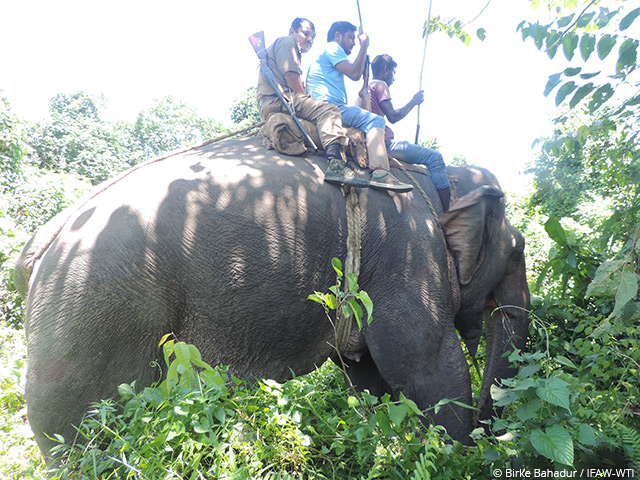 IFAW-WT I veterinarian Dr Jahan Ahmed with a forest guard and mahout atop a kumki elephant,
IFAW-WT I veterinarian Dr Jahan Ahmed with a forest guard and mahout atop a kumki elephant,
Ronga Reserve Forest, Assam, August 26, 2016: A wild ‘makhna’ (tusk-less male) elephant was chemically restrained and treated for an inflammation of its right foreleg on August 18. This marked the end of an operation spanning two weeks and involving multiple attempts by IFAW-WTI veterinarian Dr Jahan Ahmed, assisted by Dr Rinku Gohain and working with Assam Forest Department personnel, to sedate and treat this particular elephant.
The following is a first-hand account of the operation by Dr Ahmed:
A Clash of Titans
On the evening of August 3 our Mobile Veterinary Service (MVS – North Bank) received a report from the North Lakhimpur Forest Department that an injured makhna had been seen in the Bogoli beat under the Harmutty Range of Ronga Reserve Forest. We proceeded to the location the next morning but the elephant was in a densely forested area and as forest officials were unable to get a fix on its exact location, we could not intervene.
Two days later we received news that the elephant had been located. Forest staff chased it to the Bogoli River where a forest guard and I were waiting atop a ‘kumki’ (a specially trained Forest Department elephant), ready to dart it and administer the required treatment.
We saw the makhna emerge onto the river bed. It was massive, about a foot-and-a-half taller than our kumki. It had a large swelling at its right shoulder joint and was dragging its foreleg. The moment it saw us though, it charged, ramming into our elephant from behind. Our mahout, a young chap, didn’t panic. He turned the kumki towards the wild elephant and met it head-on. As the elephants battled I tried desperately to get a clear shot and dart the makhna. I did get my chance but with the rapid movements of the two elephants – and of the rather frightened forest guard behind me – I missed.
Both elephants were still fighting in the ankle deep water. We had started out near the east bank but were now on the west bank of the river. The Range Officer Rubul Pathak, DFO B Vasanthan and ACF N Das were about 150 metres away, watching the scene unfold. The makhna was now running away and our kumki gave pursuit. It was getting dark and they were running into dense forest, so the forest guard and I decided to jump off.
The Last Dart
Over the next few days we tried in vain to locate the elephant. Then, on the afternoon of August 10, it was sighted in a small stream, moving towards the river. We reached the spot and a ranger fired a dart, but missed. The makhna was moving towards the forest again when we prepared and fired another dart. It struck the gluteal muscle but didn’t fall off. It had malfunctioned. Another opportunity lost, and it was already evening; we packed up for the day.
Dr Rinku Gohain joined me on August 12 having brought more darts from CWRC. Forest staff were constantly monitoring the makhna’s movements but it was deep within the Ronga Range Forest, making any sort of intervention impossible. Finally, on August 18 we learned that it had been spotted near the Harmutty Tea Estate. We prepared two darts and I and a forest guard approached the elephant atop a kumki. It was just about 250 metres inside the forest, but since it was lying down in a thicket we couldn’t get a clear shot. We decided that it would have to be chased toward the tea garden where we would lie in wait. Unfortunately, again, things didn’t go according to plan – the makhna ran the other way, deeper into the forest!
Dr Gohain had to leave at this point to attend to an abandoned elephant calf in Dejoo Tea Estate. The forest was too dense for us to proceed on elephant back, so a forest guard and I went in on foot. We saw the elephant taking a mud bath in a swampy area. I fired a dart and it struck near the tailbone. It fell off after about five minutes and we collected it to see if the sedative had been delivered properly. We followed the makhna for about 40 minutes; it was drowsy but not yet sedated, so we fired two top-up darts.
Ten minutes later its trunk was fully relaxed and we could safely approach it on the kumki. It was 9.5 feet tall and in good health apart from the huge swelling at its right shoulder, towards the antero lateral side. There was no external injury; the area had calcified and there was no pus. I administered long acting antibiotics, anti-inflammatory drugs, anti-histamines and multi-vitamins.
After about 20 minutes the elephant moved its hind limbs. I applied a topical spray on the dart injuries, and administered an injection to counteract the anaesthetic.
We came away from the area. The makhna was seen an hour later, fully recovered from the sedative. It was browsing on grass and creepers as it moved off into the dense forest.